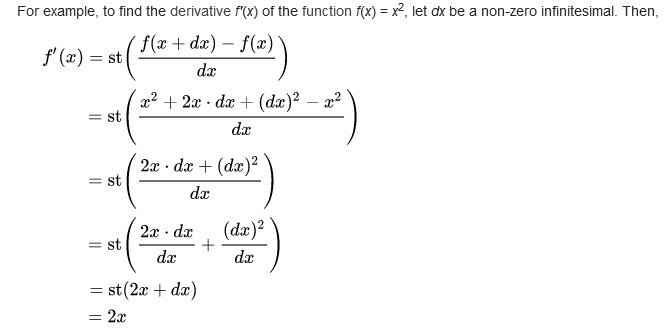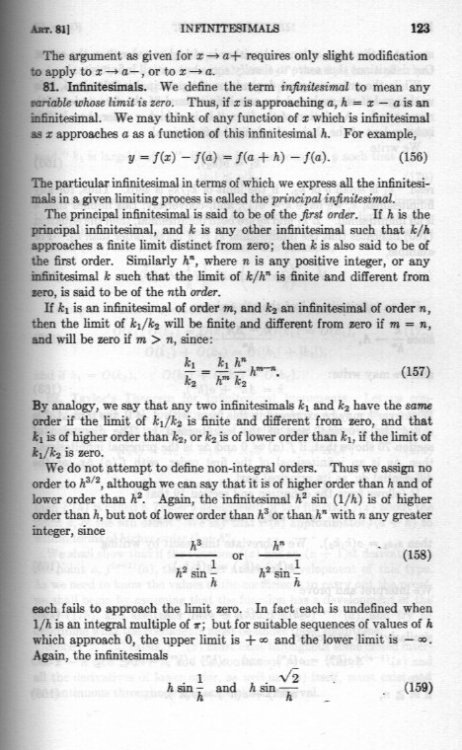-
Posts
18314 -
Joined
-
Last visited
-
Days Won
104
Content Type
Profiles
Forums
Events
Everything posted by studiot
-
I think it is truncated not rounded. I am having trouble with a conflict between the editor here and the Wiki extract I am trying to fix in my post. The paragraph following in Wiki clearly calls it a 'double number' and claims this to be rigourous.
-
Going back to Wiki Note that it specifies "let dx be a non-zero infinitesimal" dx is not zero. However the rest of the procedure is just a smokescreen for the fact that in the last line the writer is going to ignore (drop) the dx. Talking about the 'standard' part is no more justifiable than choosing only to take the real part of a complex number. The alternative I was taught was to use limits and perform algebraic manipulations (including using the rules for manipulating limits) until the last line was reached [math]\mathop {\lim }\limits_{\delta x \to 0} \left( {2x + \delta x} \right)[/math] [math] = \mathop {\lim }\limits_{\delta x \to 0} \left( {2x} \right) + \mathop {\lim }\limits_{\delta x \to 0} \left( {\delta x} \right)[/math] Then and only then was the limit taken [math] = 2x + 0[/math] We developed these for quite a few derived functions. It can immediately be seen that the algebra is the same until the end but then nothing is discarded. It also shows why the principle of working out a few appropriate fundamental examples and then relying on developing an algebra of derivatives is the usual method taught.
-
Actually I blame (at least partly) the current vogue to reduce the Maths to things like this [math]{G_{\alpha \beta }} = {T_{\alpha \beta }}[/math] (Baez on GR) [math]H\left( \psi \right) = E\left( \psi \right)[/math] (Hamiltonian formulation of Schroedinger equation) Those who have truly studied this stuff know that this is very shorthand hiding a multiplicity of equations and other stuff you would need to perform any actual calculations. But it leads others to think you can just write energy = whatever.
-
Even professors of Physics have their off days. I am not a fan of JAK as a celebrity physicist, but he was trying to express the calculus of variations as applied to geodesics in three words. He could equally have said that the apple whilst attached to the tree is moving with the rest of the universe. Once detached it does not move at all. It is just that the rest of the universe moves past it the other way. A good question is not why does the apple fall ? but Why does it move at all ? Hint ask a poet not a physicist.
-
It is indeed worth noting this as it demonstrates that the subject is not cut and dried. And there have been yet other versions of infinitesimals. Just as some have othere versions of infinitesimals, Thurston has other versions of extended numbers which he calls 'super-cauchy' numbers and 'neighbourhood of infinity numbers'.
-
Although Hewitt may have coined the term hyperreal, he did no introduce infinitesimals. They go way further back, but here is an interesting treatment from Prefessor Franklin (MIT) in 1940.
-
This has become a mess. 1) Which diagram are we supposed to be discussing ? 2) The diagrams show an xy plane (no z axis) with three currents represented by dots. Are you using the dot and cross convention for currents normal to the plane or what? If so please enclose the currents in a circle. 3) The pictures are necessarily shrunk to fit in the post but enlarge to be readable if downloaded. Thanks
-
Slightly more formal than what I said, but still defined as an 'extension'. There is a slight issue with the Wiki definition since it defines a hyper real number in terms of a number and also uses the term "greater than". Perhaps not so formal after all ? I think taeto did a good concise job of explaining why you don't need a whole universe of new numbers (symbols). +1 As to the distinction between cardinal and ordinal. Thank you for the video. I will watch it when I have time. Meanwhile here is an older definition of cardinal number which avoids the circular definition of defining a number by using the term number. (My first definition came from my mathematical dictionary) You would need to understand by similar he meant bijective. The order is irrelevant to this definition and the set may not be ordered.
-
I think perhaps there have been some transciption errors in the OP?
-
Short and sweet. Nothing more that needs adding here. +1
-
Yes, in what way does the above post answer or discuss the question of what clocks measure ?
-

How is mass divided by volume to measure density ?
studiot replied to Complexity's topic in Speculations
The cat sat on the mat and contemplated Newton's third law in the light of your statement and came to the conclusion that the statement is contrary to Newton's third law. If you cannot understand this you should ask for more detail, not retort with a smarty pants answer or simply fail to answer like you have with my comment on Newton's First law. Although you were the first person to attempt to claim the high ground by introducing Newton to this discussion. -
Droplets also have a habit of falling in time. So I suspect you also need to factor time into this as the water will eventually run out of any hole big enough to be visible.
-

How is mass divided by volume to measure density ?
studiot replied to Complexity's topic in Speculations
No it couldn't. You did ask for some more rigour and I gave it to you. I said Light is not a material body. So Newton's first law is not applicable to it. -

How is mass divided by volume to measure density ?
studiot replied to Complexity's topic in Speculations
I agree that "it is just what light does" is not very formal. But Newton's first law (which is pretty fundamental) could be stated A material body will continue doing its own thing unless acted on by a force. In the case of a material body its own thing means (is defined as) "moving in a straight line or state of rest." Similarly you could say Light will continue doing its own thing unless acted on by a focusing or deflecting agent or there is something in the way.d be defined as Where doing its own thing could be defiend as "Filling the space available to it in all directions" This would be analogous to "a gas expands to fill its container in all directions" -
No I said that the wave function has (rather peculiarly, but not uniquely) unusual dimensions (or units).
-
I think you have missed out an ex before the second sinx. Looking then at your transformation, and noting that the domain and codomain of, are the same, (so the transformation is closed), you can surely test against the linear space axioms by forming the derivatives and sums and showing there are inverses etc.
-
I think the trampoline explanation is really bad because there are two types of curvature intrinsic curvature and extrinsic curvature. The curvature introduced by GR is intrinsic curvature which means that in order to detect it does not require leaving the space (manifold) the observer is in. In more mathematical terms the space does not need to be embedded in a space of higher dimensions for a radius of curvature to exist. On the other hand trampoline curvature is extrinsic curvature, which requires embedding in a space of higher dimension. This means that the trampoline is initially a plane and pulled down into a curved shape in a third dimension at right angles to the original plane.
-
All clocks are really counters. As such they measure elapsed time or time difference at their location. This is only true if they run at a constant 'rate' (used as a horological term). For instance ancient greek water clocks ran at a steadily decreasing rate and were only capable of indicating early motning, half morning, afternoon and night.
-
I prefer to use the word complicated rather than complex partly because complex has its own special meaning in both English and Science and partly because it avoids confusion with complex numbers (especially in this case). Complex means made of of more than one part, which cannot be removed without destroying the whole. However I agree the web sometimes (often ?) overcooks the goose. So here are some simpler definitions. Cardinal does not mean it represents quantity. A cardinal number is a measure of the size of a set that does not take into account the order of its members. An ordinal number is a measure of the size of a set that does take into account the order of its members. Note I have said ordinal and cardinal number. This is more specific and avoids confusion with the adjective cardinality and ordinality. A hyper-real number is a symbol appended to a set of numbers as an 'extension'. Usually only a handful of extra symbols are appended (such as ∞) so that special rules for manipulating them can be set up and applied. This is in some ways similar to the one special rule we have in ordinary arithmetic forbidding division by zero. Is this English plane plain enough?
-

How is mass divided by volume to measure density ?
studiot replied to Complexity's topic in Speculations
Was that the google search, babies version? This is surely your cue to introduce one of your favourite topics - limits. Beacause most type of density (and there are many current density, probability density......... the list is long) As to the 'division', no it is not division at all it is the ratio of one independent quantity to another, as one of them tends to zero. -

Boltzmann Brains (split from Spacetime is doomed.)
studiot replied to Conjurer's topic in Modern and Theoretical Physics
From my link This couldn't be clearer. I have referred to the Boltzman Distribution many times in this thread. -
I am puzzled by your mixing up very tightly defined words in Physics into inappropriate equations and statements. In particular what do you mean by a linear force? What are you distinguishing this from? What exactly do you mean by this equation ? Is this your difficulty?
-

Boltzmann Brains (split from Spacetime is doomed.)
studiot replied to Conjurer's topic in Modern and Theoretical Physics
Perhaps you should re-read what I actually said. But before you do or search for advanced research papers, I suggest you find out what is meant by a 'state' and a 'state variable'. Boltzman's state variables were not position or momentum. They were energy and temperature. And his results are deterministic, as stemming directly from deterministic equations. Try looking here for some mathematics. http://hyperphysics.phy-astr.gsu.edu/hbase/Kinetic/maxspe.html -
Read here http://hyperphysics.phy-astr.gsu.edu/hbase/quantum/parlif.html#c1



